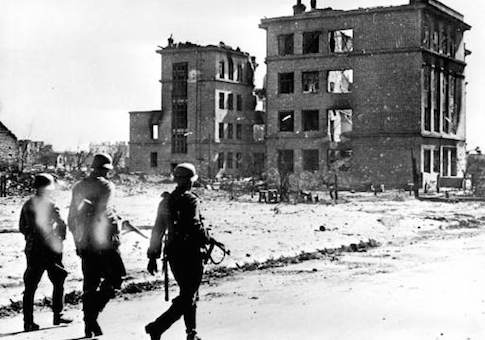U.S. Marines often conduct live fire training on ranges that feature "Ivan" targets. These thin green plastic shells look like three-foot-tall army men toys. Ivan has no distinguishable facial features and he only exists so that Marines can pummel him with rifle and machine-gun bullets. That these simple targets are still called Ivan more than 20 years after the collapse of the Soviet Union is a testament to the enduring legacy of the Cold War and decades spent preparing to fight the Red Army.
Even for those well versed in the history of World War II, the Soviet soldier seems to have the depth and substance of a thin plastic Ivan target. The secrecy of the Soviet state and cultural stereotypes contribute to an image of poorly trained peasants forced to fight under the threat of execution if they retreated.
In his compelling new history of the Battle of Stalingrad, Jochen Hellbeck uses recently discovered documents to round out our picture of the soldiers who fought in horrendous conditions to block Hitler’s final thrust into the Soviet Union. While Hellbeck provides some context and analysis, the majority of the book consists of translated transcripts of interviews conducted soon after the battle. From generals to privates, the men and women whose firsthand accounts of history’s bloodiest battle are recorded here endured injury, hunger, and the constant threat of death as they fought from piles of rubble to keep the Germans from taking full control of the city.
Vivid scenes of close combat and extreme deprivation fill the pages of Stalingrad: Soviet infantrymen destroying German tanks, nurses carrying wounded soldiers off the battlefield under fire, boat crews braving artillery and air attacks to shuttle troops and supplies across the Volga to Stalingrad. Red Army soldiers also had to contend with disease, polluted drinking water, and ammunition shortages.
It is easy to see why desertion and unauthorized retreat became a problem for the Red Army. Hellbeck documents poor discipline and the presence of "blocking squads" tasked with stopping fleeing troops. He cites evidence suggesting that less than two percent of retreating soldiers were executed on the spot, while the vast majority were returned to their units to continue the fight.
The perception of widespread intentional fratricide may have its origin in some high-profile executions. Early in the battle, General Vasily Chuikov, commander of the Soviet 62nd Army, personally shot six of his own officers who allowed their units to fall back from the front line. These executions were carried out in front of the assembled units that the condemned had led as a deterrent against others retreating without orders.
The threat of execution was a factor in making the Soviet soldier fight, but Hellbeck argues that the communist ideology promoted by political officers was a bigger influence. Commissars were the party’s direct representatives in all units of the Red Army, conducting discussions with soldiers on the front lines, reviewing the day’s fighting, and explaining their collective sacrifice in terms of the global communist movement.
Their work was not only political—commissars were active participants in combat, often leading from the front. Here is how a commissar described his mindset in the eerily quiet moments between a withering enemy artillery barrage and the assault by German infantry:
Now pull yourself back together, get ready to fight, and even if you’re half dead, if you’ve only got one good arm, use it to shoot the enemy. Deal with that first one coming on the attack. Just deal with that first one. Your first shot will encourage your comrades...I’m not letting the enemy in my sector, there’s nowhere for me to fall back to.
The requirements for membership in the Communist Party were simplified for soldiers actively engaged in combat. Commissars on the Stalingrad front would accept applications from soldiers who had killed at least one "Fritz," or German soldier. One commissar remembered a junior officer who was mortally wounded while in the process of joining the party: "As he was dying he talked about his membership card, wondering whether he’d been admitted to the party." A nurse who was offered Party membership made her way through an active battlefield to reach a command post where her induction ceremony took place. These are words and actions of people not coerced, but committed to their beliefs.
It is important to keep Soviet history in mind when thinking about morale at Stalingrad. During the Russian Civil War, Joseph Stalin led communist forces in defending the city of Tsaritsyn against the White Army. The city was renamed Stalingrad in 1925 to recognize this achievement. Soviet soldiers who fought at Stalingrad did not see Stalin as a ruthless dictator responsible for the deaths of millions; most, according to Hellbeck, were proud to be fighting in the same city that he had defended.
This book reminds us, above all, of the power of ideology. Its evils notwithstanding, communism inspired the men and women of the Red Army, who, whatever else might be said of them, fought bravely to defend their homeland, many of them making what all of us will recognize as the ultimate sacrifice.
